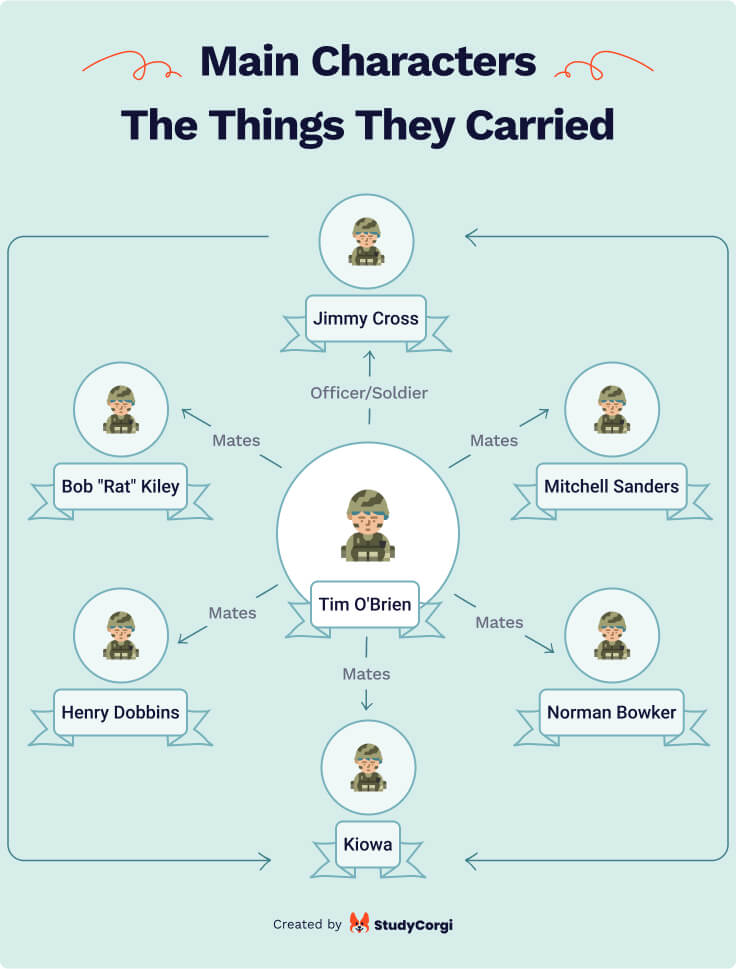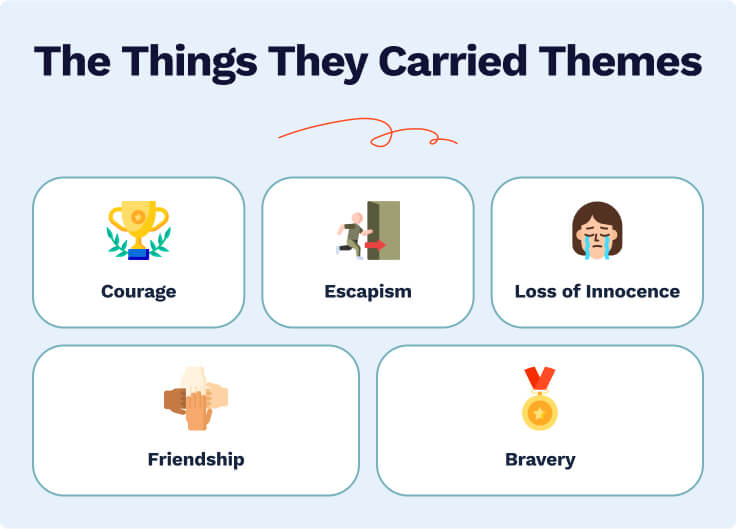The Things They Carried, a collection of short stories about American soldiers during the Vietnam War, was written by Tim O’Brien and published in 1990. Through specific rhetorical and literary devices, The Things They Carried blends real-life details with fiction, creating a blurry picture that mixes truth and fabrication. Its world is highly symbolic: even the physical objects carried by the characters symbolize their emotional burdens. Vivid descriptions and imagery in The Things They Carried immerse its readers in the story’s essence. By combining the themes of beauty and horror, humor and tragedy, and chaos and peace, the author highlights the contradictions of war.
In summary, The Things They Carried compels readers to question what’s real and what’s imagined through its masterful use of literary and rhetorical devices.
Want to learn more? Read on The Things They Carried literary analysis!
📄 The Things They Carried: Summary
The Things They Carried, in summary, is a collection of interrelated short stories based on the Vietnam War, which took place from 1955 to 1975 between North Vietnam and South Vietnam, with the US supporting the South. The author of The Things They Carried, Tim O’Brien, is an American novelist who participated in the war. Most of his novels are about the war or the situation and the veterans post-war. He wrote The Things They Carried after returning to the US.
It is semi-autobiographical as he writes about his own experiences with a bit of fiction mixed in. This type of writing is called metafiction, as it merges fiction with non-fiction. An example of metafiction is the main fictional character of the novel Tim O’Brien. The author uses this character to explore his own emotions, and while he named him after himself, the readers should still keep in mind that Tim O’Brien is not real.
He uses this trick several times throughout the book leaving his readers confused about what actually happened and what was made up. The reason O’Brien uses this technique is to highlight the importance of storytelling. In his opinion, stories do not have to be entirely true to be believable.

The novel describes a group of soldiers named “Alpha Company.” The characters reappear throughout the different stories of the collection. Tim O’Brien is drafted for the war in 1968. Besides his political beliefs, he decides on going to ensure his reputation does not get damaged. He joins the Alpha Company in Vietnam.
Most of The Things They Carried characters end up dying in different ways, such as Kiowa, Lemon, or Lee Strunk. With each character’s death, the group experiences devastation, especially after Kiowa’s death, who is O’Brien’s best friend. Some of the stories are told from the perspective of twenty years after the war. The purpose is to illustrate that the trauma of war does not leave people even after so many years. It depicts the senselessness and the inhumane conditions of combat.
O’Brien does not only deal with his experiences of the war. He also uses those as a means to understand some of the earlier events in his life. An example of that is the death of his fourth-grade love interest, Linda.
Now, let’s analyze the novel!
🔍 The Things They Carried: Literary Analysis
In the upcoming sections, we will introduce you to many topics from The Things They Carried for your analysis of the book. We will go through the novel’s setting, the characters and their traits with some backstories, the themes of the novel, and the literary devices used to enhance the readers’ experience. Are you ready? Let’s start!
What is the message of The Things They Carried?
The Things They Carried is about the emotional burden soldiers carry during the war and throughout the rest of their lives. It portrays many struggles faced by soldiers at war that are incomprehensible for people who never participated in one. O’Brien’s storytelling is impressive in terms of passing emotions onto his readers.
Setting
The Things They Carried is set mainly in Vietnam, while parts of it happen in the US. It focuses on the years from 1969 to 1971, when the US actively engaged in the Vietnam War. The territory is mostly jungles, so soldiers always need to find their way around them. O’Brien and his group serve in The Quang Ngai Province, which is a Viet Cong Stronghold. It is a South Vietnamese guerilla province supporting North Vietnam in the war.
They are not very aware of their surroundings or whereabouts as they constantly relocate to places without understanding where they are going and why. In other words, the setting was very confusing for the soldiers as it did not make sense. Some parts of the book happen in a small American town depicting the soldiers’ lives after returning from the war to their hometowns.
Let’s explore the characters!

List of Characters
This section will introduce you to the different characters in The Things They Carried, what they are meant to represent, and how they are significant to the stories. We will also summarize what happens to each of them.
Tim O’Brien
Tim O’Brien is the main character of the novel and the narrator. He is the source of all the information, whether fictional or real. In the story, Tom is a middle-aged writer from the Midwest of the US. The Things They Carried is a memoir of his fears and experiences throughout the Vietnam War.
Bob “Rat” Kiley
Rat is the medical professional of the group who helps O’Brien when he gets shot. He is very imaginative and is known for exaggerating stories. He eventually goes crazy and starts hallucinating. To end his suffering, he shoots himself to be freed from the war due to injury.
Kiowa
Kiowa is a Native American Baptist. He always keeps a copy of the New Testament with him. He is O’Brien’s best friend. He dies by drowning in a field during a flood. O’Brien is significantly affected by Kiowa’s death which is evident in many chapters of the book.
First Lieutenant Jimmy Cross
Jimmy Cross has trouble with separating his feelings from the war. Though he is the group leader, he is not a very productive one as his emotions always get in the way. He spends most of his time thinking about his old lover Martha.
Azar
Azar is obsessed with the idea of war, and he enjoys it. He is not there because he believes in the cause of the war or wants to support his comrades. The idea of war itself is what keeps him there. He is somewhat cynical when it comes to the war and often jokes about death.

Mitchell Sanders
Mitchell Sanders is the radio officer of their group, and he is known for his wisdom and practicality. Sanders believes that Lieutenant Cross is an incompetent leader and finds him partially guilty for Kiowa’s death. He is known for his storytelling and for being a mentor for other soldiers. Most of his stories are about other soldiers participating in the war.
Norman Bowker
Bowker is a foot soldier who cannot overcome the effects of war even after returning home. He blames himself for Kiowa’s death and generally hates the idea of being alive while most of his friends are dead. He eventually commits suicide. Norman was the embodiment of the author’s guilt towards Kiowa’s death.
Henry Dobbins
Dobbins, despite his huge size, is a kind man with sympathy towards everyone. Cruelty, especially at war, makes him angry. Overall, he is a very ethical man and treats everyone with respect no matter the circumstances, whether they are friends or enemies. He is also very superstitious.
Mary Anne Bell
Mary is one of the few female characters in The Things They Carried, who arrives at the war as another soldier, Mark Fossie’s girlfriend. Upon arriving, she is dressed in a pink sweater like a typical suburban girl from the US. Eventually, she becomes the scariest soldier of the group, a real weapon of death. In The Things They Carried, Mary Anne represents the destruction of innocence that happens on a battlefield.
Curt Lemon
Curt is an irrational man, constantly trying to prove his masculinity by putting himself in unnecessary danger. He asks the dentist to take out his healthy tooth to show his strength. He dies by stepping on a booby trap.

Lee Strunk and Dave Jensen
They are best friends who represent true comradeship at war. They become friends by fighting over a stolen jackknife. They promise to kill the other if he is faced with a severe wound. When Strunk loses a leg, he changes his mind and asks Jensen not to kill him, but later ends up dying somewhere, which comes as a relief to Jensen.
Bobby Jorgenson
Bobby is the medical professional who joins the group instead of Rat Kiley. He is very inexperienced and afraid. When O’Brien gets shot the second time, Bobby fails to help him, resulting in O’Brien getting a severe infection. Later, O’Brien and Azar play pranks on Bobby to make him pay for not helping O’Brien properly.
Civilians
All of the civilians mentioned in the novel have one thing in common: they all fail to empathize with war participants. For example, Martha, Cross’s lover, Curt Lemon’s sister, O’Brien’s daughter Kathleen and a couple of others.
Elroy Berdahl
When Tim gets his draft notice for the war, he runs away from home. He meets Elroy, who gives him food and shelter and helps him brainstorm ways to avoid going to war. He offers Tim to cross the border to Canada and suggests many ways for him to do that.
Mark Fossie
Mark Fossie is a medical professional for another group. He brings his girlfriend, Mary Anne Bell, with him from the US. He gets devastated when Mary is more excited about the war than about their future wedding.
What conflicts does the novel explore? Let’s see!
Conflict
In The Things They Carried, the central conflict is the the Vietnam war. O’Brien focuses on many ways war can affect a person. Each character in the book represents a specific emotion or outcome of the war.
There’s an internal conflict that emerges in characters of The Things They Carried. Some can go crazy and start hallucinating; some can become extremely violent, while others try to preserve their humanity by staying ethical and kind. Some also try to escape by running away to avoid being drafted, committing suicide, or abusive drug usage.
Another conflict is the one of confusion within one’s beliefs. The soldiers do not know why they are fighting as they do not believe in the cause of the war. The level of patriotism is lower than expected. Their lives are of higher priority than the cause.

Themes
Now, let’s look at some themes and literary devices used in the novel!
Courage
O’Brien going to war instead of fleeing to Canada because of his fear of being known as a coward falls under the theme of courage in The Things They Carried. He is worried about what other people will think of him. However, when he gets there, he realizes how ridiculous this idea of courage is as he is faced with death.
Escapism
Instead of fighting the war itself, most participants try to do everything to escape it. For example, Cross focuses on Martha and spends his time thinking about her; some play games and do drugs, while others hang on to souvenirs and superstitious ideas to escape their situation.
Loss of Innocence
Most people come to war at the age of 18, fresh out of high school and still very innocent. O’Brien points out how they quickly lose their innocence as they are forced to kill on command. Some of them even enjoy it. They become eviler as the days pass by.
Friendship
The friendship shared between the soldiers proves to be the strongest bond people can have. They protect each other by sacrificing their own lives; they give each other promises that are too hard to keep and are the only ones who can empathize with each other.
Another theme from the novel is bravery. You can explore it further in our essay sample.

What Is O’Brien’s Definition of Truth?
According to O’Brien, if something stimulates the birth of genuine emotions, then it is true. He emphasizes that war stories can never be absolutely true, as the war participants tend to lose their sense of what is definite. So, in The Things They Carried, he tries to pass this feeling of confusion regarding the truth onto his readers.
The Things They Carried tells the story of the Vietnam War and touches upon common themes in all wars. It is one of the very few pieces of literature that illustrates the actual struggles of soldiers.
Devices
This section focuses on the literary devices employed to enhance the novel and the reader’s emotional experience. The author uses these devices to deliver his message in alternative ways.
Symbolism
Symbolism in The Things They Carried is displayed in many instances. For example, Kiowa is a Native American who dies in a sewage field during the war. He is also a rather moral character. Kiowa is the symbol of American morality and ethics drowning in the war. Another character, Norman Bowker, thinking about Kiowa’s death, starts driving in circles for a very long time. This symbolizes his confusion towards the matter and his inability to express his feelings.
Imagery
The usage of imagery in The Things They Carried is quite frequent. For example, O’Brien sometimes uses sunrises or sunsets to illustrate that life is still beautiful despite their horrible situation. Lemon dies on a bright day, which O’Brien remembers happened under yellow sunshine. This is why his name can also be associated with the color yellow.
Allegory
“The whole atmosphere, they carried it, the humidity, the monsoons, the stink of fungus and decay, all of it, they carried gravity.” O’Brien writes this in a broader sense. He means that soldiers are forced to carry so many dirty and heavy things within themselves that can be compared with humidity and fungi in an emotional mind.
Juxtaposition
The following thought is an example of O’Brien’s usage of juxtaposition: “The only certainty was moral confusion.” You can find phrases like this quite often in his writing. Another example of juxtaposition is the girl that dances around the corpses. It places moral and physical death next to each other.
The Things They Carried Essay Topics
Well, that’s it! Did you find all the information you were looking for? We certainly hope so! Make sure to check other articles if you liked this one! 😄
